Your Electric Guitar Could Be Worth Thousands: Here’s How to Tell & Where to Sell
Contents
- How much are electric guitars worth?
- What makes electric guitars valuable?
- How to find electric guitar values
- Where to sell electric guitars
- Electric guitar selling tips
How much are electric guitars worth?
There are several very valuable guitars, but the most valuable production models are the original 1958 to 1960 Gibson Les Paul Standard (Burst), 1958 to 1959 Gibson Flying V and Explorer models, 1959 Gibson ES-335N TD, 1957 Gibson Les Paul Goldtop and the original 1954 Fender Stratocaster.“These guitars have been documented to sell for anywhere between $50,000 and $650,000,” says Daniel Escauriza, Vintage Manager and Head Vintage Buyer for Chicago Music Exchange.
Leonard Wyeth, who operates AcousticMusic.org and the Association of Stringed Music Appraisers alongside Brian Wolfe, says the 1958 to 1959 Gibson Explorer can be worth as much as $700,000.
“Another favorite is the 1958 to 1960 Les Paul Standard, which can fetch as much as $400,000 depending on the year and the amount of flame in the maple cap,” he says. “The 1958 to 1959 Korina wood Gibson Flying V can run as much as $375,000.”
Guitars owned by celebrities can be even more valuable, especially those owned by famous singer-songwriters and those used for special recordings or concerts, says Wyeth.
“Think of Paul McCartney and John Lennon, Jimi Hendrix, Jimmy Page, Eric Clapton or Jerry Garcia as examples,” he says.
The most expensive guitar ever sold at auction was a Fender Stratocaster signed by multiple music legends, including Mick Jagger, Eric Clapton, Paul McCartney, Jimmy Page, Keith Richards, Bryan Adams and Brian May. The Strat went for $2.7 million at a 2005 charity auction for Reach Out to Asia.
In 2002, a 1973 Doug Irwin guitar named “Wolfe” and previously owned by Grateful Dead lead man Jerry Garcia sold for $1.9 million at auction.
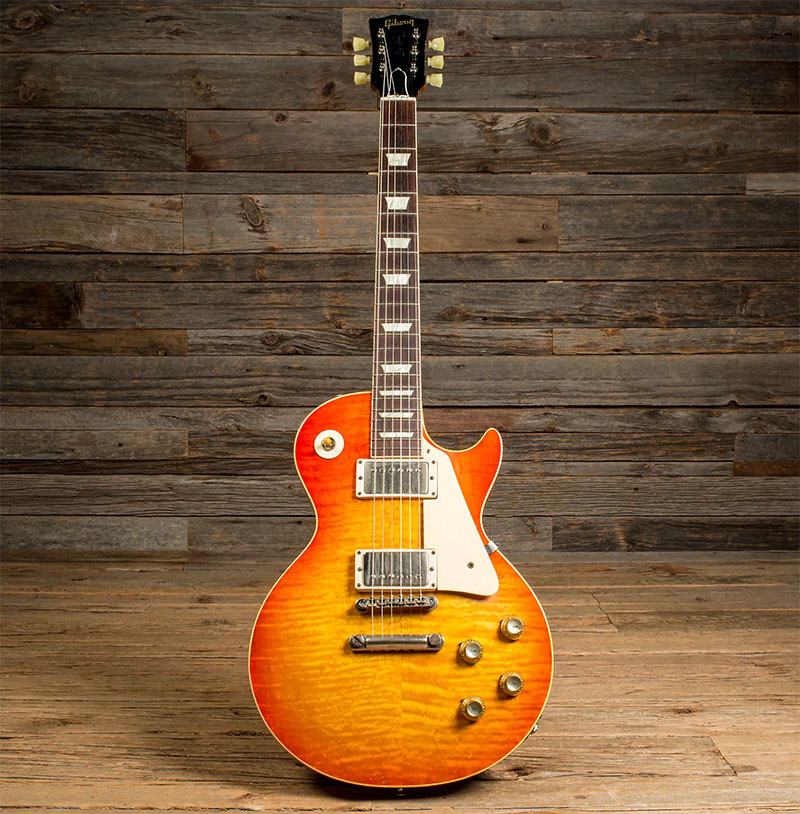 1960 Gibson Les Paul Standard (Burst). Source: Chicago Music Exchange
1960 Gibson Les Paul Standard (Burst). Source: Chicago Music Exchange Of course, those are examples of the most valuable electric guitars and not indicative of what an average guitar is worth. Wyeth says there is no average guitar value.
“There are too many factors to consider,” he says. “If you are asking what anyone could find new or used in the typical music store, an import student-grade electric guitar could be found for $200 to $300, as well as many other imports. There are cheaper ones and certainly better and more expensive ones.”
Quality-built mid-level electric guitars are worth anywhere between $500 and $1,500, says Escauriza, and even less if they’re used. Here are some used electric guitar values as appraised by Reverb.com, a popular music gear website that offers a price guide based on expert research, market data and real-time on-site transactions.
| GUITAR | ESTIMATED VALUE |
| D’Angelico EX-SS 2010s Grey Black | $780-$950 |
| D’Angelico EX-SS 2010s Sunburst | $760-$1,035 |
| Dean V Standard USA 1982 Red | $600-$900 |
| Dean V-X 2000s Black | $135-$205 |
| Epiphone Casino Coupe 2010s | $305-$395 |
| Epiphone Dot 1999 Cherry | $250-$375 |
| Epiphone Zephyr 1958 Sunburst | $1,810-$2,825 |
| ESP LTD M-10 2000s Black | $100-$140 |
| ESP Traditional EXC MIJ 1993 Turquoise | $750-$1,150 |
| Fender American Standard Stratocaster 2015 Mystic Sunburst | $700-$1,000 |
| Fender Custom Telecaster 1963 Sunburst | $15,000-$20,000 |
| Fender Standard Stratocaster 1992 Black | $290-$405 |
| Fender Standard Stratocaster 2015 Black | $315-$455 |
| Fender Standard Telecaster 1992 Sunburst | $275-$400 |
| Fender Standard Telecaster 2010 Black | $300-$420 |
| Fender Stratocaster 1956 Sunburst | $20,485-$24,950 |
| Fender Stratocaster 1960 Sunburst | $13,540-$20,230 |
| Fender Stratocaster 1975 Sunburst | $1,800-$2,400 |
| Fender Telecaster 1976 Natural | $1,785-$2,030 |
| G&L S-500 2000s Common Finish | $705-$930 |
| G&L Tribute ASAT Deluxe 2010s Figured Top | $255-$380 |
| Gibson ES-335 Fat Neck 2006 Ebony | $2,200-$2,700 |
| Gibson Explorer 1976 Natural | $2,190-$4,415 |
| Gibson Flying V 2007 White | $720-$950 |
| Gibson Les Paul 1957 Goldtop | $65,000-$85,000 |
| Gibson Les Paul Standard “Burst” 1960 | $140,000-$240,000 |
| Gibson Les Paul Studio 2011 Satin Blue | $530-$700 |
| Gibson Les Paul Studio 2016 Alpine White | $820-$1,005 |
| Gibson Les Paul Studio Custom Mid ’80s Sunburst | $1,400-$1,900 |
| Gibson SG Standard 1977 Walnut | $1,070-$1,690 |
| Gibson Snow Falcon Flying V 2013 White | $1,420-$2,280 |
| Gretsch 6120 Nashville 1966 Orange | $2,000-$3,000 |
| Gretsch G5120 Electromatic 2010 Black | $350-$480 |
| Ibanez GB10 2000s Sunburst | $1,375-$1,770 |
| Ibanez RGKP6 2010s Black | $230-$345 |
| Ibanez ST50 1980s Sunburst | $360-$515 |
| Ibanez Stagestar 1997 Black | $100-$200 |
| Jackson Dinky Standard 1990s Red | $250-$450 |
| Jackson Randy Rhoads Tribute V 2010 Polka Dots | $5,500-$7,000 |
| Paul Reed Smith P22 2010s Flame Top | $1,880-$2,855 |
| Paul Reed Smith SE One Natural | $255-$415 |
| Peavey EVH Wolfgang 1990s Black | $880-$1,415 |
| Peavey EVH Wolfgang 1990s Cherry Sunburst | $1,020-$1,445 |
| Rickenbacker 340 1980 Jetglo | $2,200-$3,000 |
| Rickenbacker 4001 1961 Fireglo | $7,000-$10,000 |
| Schecter A-7 1999 Black | $200-$300 |
| Schecter Ultra II 2011 Titanium | $300-$450 |
| Squier II Stratocaster 1980s Black | $130-$200 |
| Squier Standard Telecaster 1990s Black | $240-$395 |
| Squier Standard Telecaster 2012 Antique Burst | $140-$225 |
| Squier Venus 1997 Sunburst | $350-$570 |
| Squier Venus 1997 Surf Green | $520-$750 |
| Squier Vintage Modified Stratocaster Surf 2012 Sea Foam Green | $210-$330 |
| Washburn HB35 2010s Cherry | $300-$360 |
| Washburn J-600 2013 Vintage Matte Sunburst | $380-$485 |
| Yamaha Pacifica 012 2000s Red | $100-$135 |
| Yamaha SBG500 1980s Red | $255-$590 |
What makes electric guitars valuable?
Electric guitar values are determined by a combination of factors, including:- Originality
- Condition
- Manufacturer/Luthier
- Country of manufacture
- Age (vintage, used or new)
- Materials/level of appointments
- Color
- Rarity and desirability
- Provenance
Originality
Many guitarists love to tinker with their guitars. They’ll swap out pickups, change tuning pegs and add new pick guards, for example. However, in most cases guitars that feature their original components are more valuable than those that do not.Condition
“Many factors come into play, with condition and originality being the key details that determine the high end of a guitar’s value,” says Wyeth. “In the case of vintage guitars, condition that is not represented accurately can create considerable problems for buyers.”He adds that you can find examples and descriptions of guitars in varying conditions in guide books like The Vintage Guitar Price Guide, which is available in both print and digital editions. In general, electric guitars are graded according the following scale:
- Mint: Perfect like-new condition with no imperfections
- Excellent: All original and free of visual defects
- Very Good: May have minor cosmetic imperfections that do not affect playability
- Good: Plays perfectly but may have imperfections such as a cracked binding and dents
- Fair: Has damage that may slightly affect playability
- Poor: Damage that renders the guitar difficult to play and requires repair
- Broken: Advanced damage such as a broken neck that renders the guitar unplayable
Manufacturer/Luthier
Guitars manufactured by Gibson and Fender are among the most valuable. These companies also have secondary brands that produce cheaper guitars that bear the names of their most popular models, often made overseas.For example, a Fender Telecaster is worth more than a Squier Telecaster. Other manufacturers that produce valuable electric guitars include Paul Reed Smith, G&L, Rickenbacker, Ibanez, ESP, Jackson, Schecter and Epiphone.
Note that there is still a wide range of values ascribed to guitars crafted by these makers, and worth is primarily dependent on other factors. In addition, there are smaller custom guitar makers who craft valuable guitars.
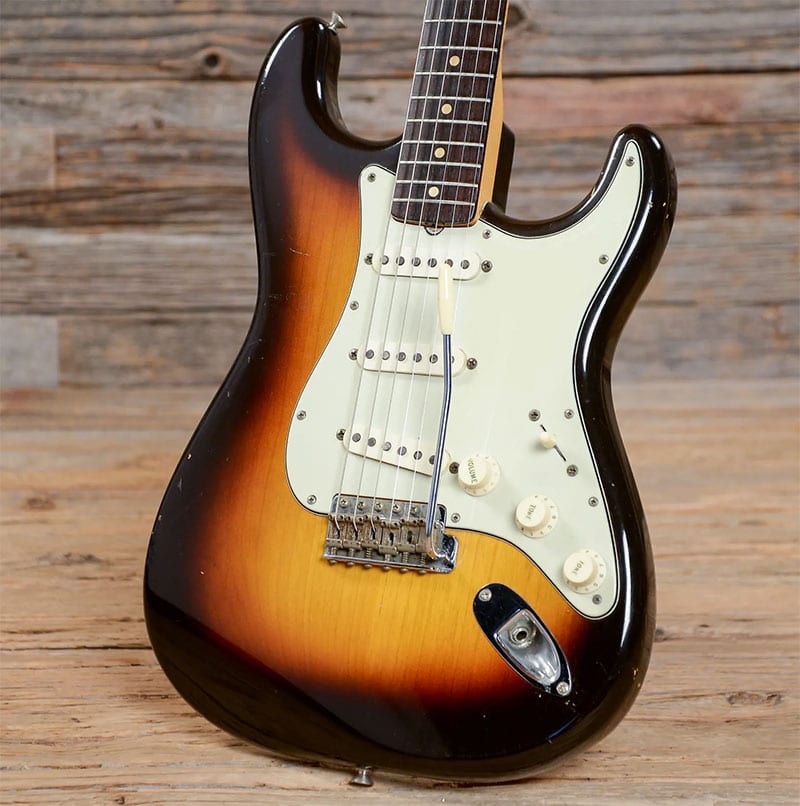 1960 Fender Stratocaster RW Sunburst. Source: Chicago Music Exchange
1960 Fender Stratocaster RW Sunburst. Source: Chicago Music ExchangeCountry of manufacture
Where a guitar is made can have a major impact on its value. For example, Fender famously splits production between the U.S. and Mexico, and U.S. models are deemed to be of higher quality and are therefore more valuable.“A brand new American-made Deluxe Stratocaster is worth significantly more than a brand new Mexican-made one,” says Escauriza.
Age
Vintage guitars tend to be worth more than new guitars, especially if it’s a popular and desirable model.“A vintage Stratocaster from the 1960s, when they were only made in the USA, is worth significantly more than a new one,” says Escauriza.
Materials/Level of appointments
Higher-quality materials and level of appointments add value to guitars. For example, guitars that feature high-end pickups are more valuable than those with standard pickups. A guitar body crafted from maple can be worth more than one made from mahogany, and fretboards made from ebony wood can be more valuable than the commonly-used rosewood.In addition, higher-end models get the best materials: two guitars might be made from maple, but the more expensive version is crafted from the more beautiful piece. A premium guitar might have gemstone fretboard inlays versus standard plastic inlays.
Guitar appointments are cosmetic add-ons. Guitars with better appointments are more valuable. Examples include binding, fretboard inlays, pick guards, volume and tone knobs and switch caps.
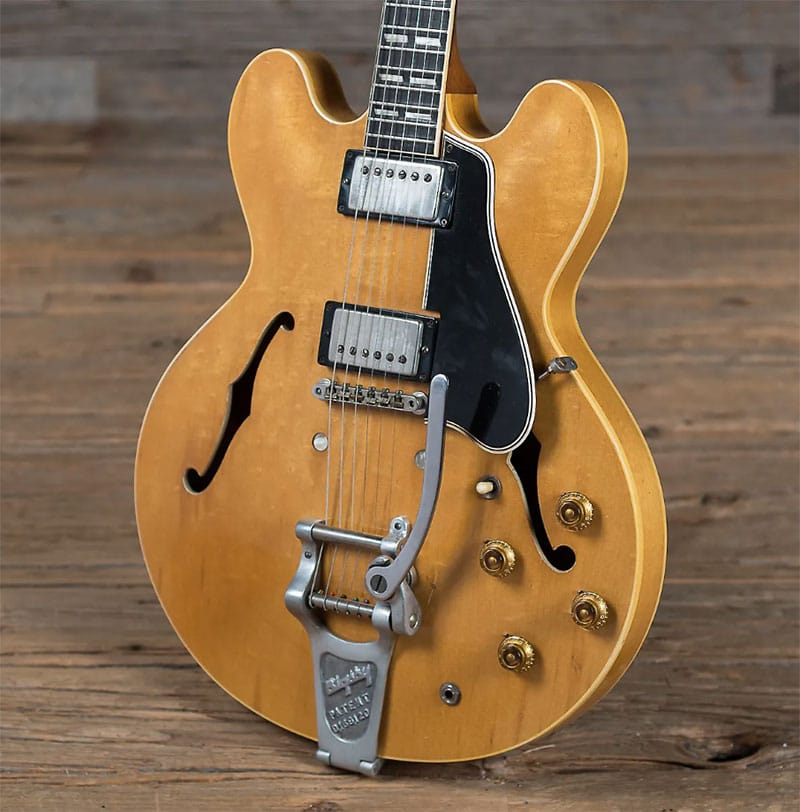 1960 Gibson ES-335 TDN with Custom Factory Split Parallelogram Inlays and Bigsby Natural. Source: Chicago Music Exchange
1960 Gibson ES-335 TDN with Custom Factory Split Parallelogram Inlays and Bigsby Natural. Source: Chicago Music ExchangeColor
Color can impact the value of a guitar, in part because some colors are more desirable than others but also because some guitar finishes are rare.Rarity and desirability
The most valuable guitars are both rare and desirable – in other words, electric guitar values adhere to the laws of supply and demand.Good examples include original Les Paul Standards, 1958 to 1959 Gibson Flying V’s and Explorers, 1957 Les Paul Goldtops and 1954 Fender Stratocasters. These are among the most rare and desirable guitars, and therefore some of the most valuable, commanding anywhere between $50,000 and $650,000.
Provenance
How many owners a guitar has had, and who they are, can contribute to guitar value. Guitars that have only been owned by one person and those who have been owned by well-known musicians and celebrities are worth more. As the seller, you bear the burden of proving any claims you make about your guitar’s provenance. 1969 Fender Telecaster Olympic White. Source: Chicago Music Exchange
1969 Fender Telecaster Olympic White. Source: Chicago Music ExchangeHow to find guitar values
As noted, many factors dictate guitar values, so it’s important to understand what you have so you can accurately determine its value.“As a buyer, it’s best to know exactly what you are buying and why you are paying $10,000 for a yellow Gibson Les Paul TV model and $6,000 for a red Gibson Les Paul Junior from the same year, the only difference being color,” says Wyeth.
At minimum, you should know your electric guitar’s year, model, manufacturer, country of manufacture, originality and condition. Once you know those, use these resources to find out how much it’s worth.
Professional assessment and appraisal
“Without a doubt, getting the instrument professionally assessed by professionals who can authenticate it and have a good understanding of the ever-changing vintage market is the best way to determine the value of a vintage or used instrument,” says Escauriza. “We offer a service to help people figure out the value of their instrument if they are interested in selling it.”Wyeth adds that it’s easy to be led astray if you’re not familiar with guitars and have no knowledge of their history and details.
“I would recommend contacting a respected instrument dealer,” he says. “If you have an instrument that you believe to be significant, there are organizations of experts than can help.”
Options include the Association of Stringed Instrument Appraisers and Chicago Music Exchange.
Reverb
The popular music gear marketplace features a free price guide based on expert assessments, external market data and real-time Reverb transactions to estimate the value of guitars in used but original condition.“There are some great resources that can give someone a pretty clear idea of the value of a certain piece,” says Escauriza. “The most intuitive and easy-to-use online option is the price guide on Reverb. Reverb also has great resources for dating instruments.”
eBay
Search for your electric guitar on eBay and filter by sold listings to see how much similar guitars have recently sold for. Be sure you’re comparing apples-to-apples and compare multiple sales to get an accurate sense of the value of your electric guitar.The Vintage Guitar Price Guide
Vintage Guitar Magazine partners with 35 top guitar dealers to publish its annual pricing guide, which is available in print and digital editions for $35.Blue Book of Guitar Values
A pricing reference for both new and vintage guitars. You can buy 7-day subscriptions for individual guitar models for around $3. The print edition featuring all models is available for $28 and one-year access to the searchable online electric guitar edition is $30.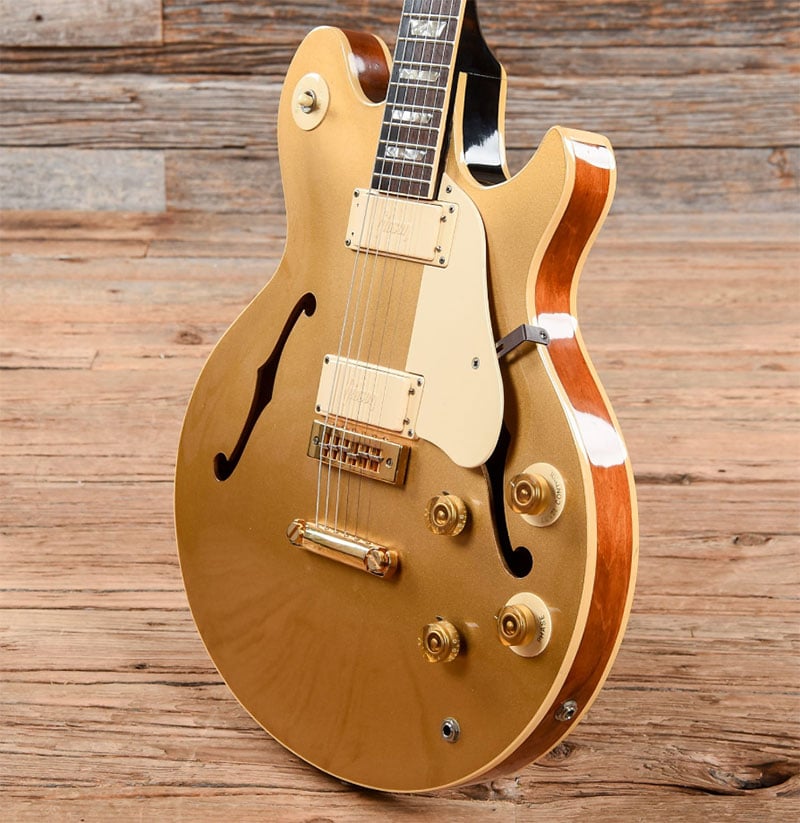 1970s Les Paul Signature Goldtop. Source: Chicago Music Exchange
1970s Les Paul Signature Goldtop. Source: Chicago Music ExchangeWhere to sell electric guitars
Electric guitar selling options include:Online guitar shops
Guitar shops are staffed by experts who can quickly tell you what your guitar is worth and generally pay in your choice of cash or store credit. Some shops, like Guitars For Trade, accept trade-ins, which is ideal if you’re looking to upgrade your axe.Examples include:
Online marketplaces
Online marketplaces let you list your electric guitar for peer-to-peer sales. Listing is free on some sites (Reverb, eBay) and you’re charged a commission when your guitar sells.If you have many guitars to sell, you might consider Gbase, which lets you create a store for a flat $35/month rate with no commissions. The Sweetwater Used Gear Marketplace is completely free with no listing fees or commissions.
Examples include:
Online forums and Facebook groups
Many electric guitar forums include classifieds threads where you can buy, sell and trade your guitar. There are general guitar forums as well as forums dedicated to specific models like Telecasters and Les Pauls. You can also check out Facebook groups.Note that sales are typically unmoderated, so you should secure payment or escrow before you ship a valuable guitar.
Examples include:
- Guitar Noise
- Ultimate Guitar
- Guitarists.net
- Harmony Central
- Telecaster Discussion Page Reissue
- Strat Talk
- My Les Paul
- The Les Paul Forum
- Guitars: Buy, Sell Trade
- Buy Sell Trade Guitars
- Gibson Guitars: Buy – Sell – Trade
- High End Guitars: Buy, Sell and Trade
Local options
Local options offer benefits like fast cash and no shipping, but a limited pool pool of potential buyers. If you’re meeting a private buyer face-to-face, meet in a well-lit and busy public area and take a friend along for your safety.Examples include:
- Local guitar shops
- Craigslist
- Facebook Marketplace
- Apps like OfferUp and LetGo
- Pawn Shops
- Flea Markets
 1964 Gretsch 6120 Chet Atkins Hollowbody Orange. Source: Chicago Music Exchange
1964 Gretsch 6120 Chet Atkins Hollowbody Orange. Source: Chicago Music ExchangeElectric guitar selling tips
Follow these tips for a better selling experience.1. Know what electric guitar you have
Conduct ample research and consult experts if needed to understand exactly what electric guitar you have and what it’s worth. This will help you get a fair price and temper expectations if your guitar isn’t particularly valuable.2. Compare multiple selling options
Determine what your goals are and compare multiple options to get the best deal. For example, if you want the highest price and you’re willing to wait, you might get it by selling directly to a collector via a forum or classifieds site that has no fees.Alternatively, online marketplaces could drive the price up as buyers compete for your guitar, but you need to account for fees and shipping costs in your net profit.
If you want a quick and easy sale, a guitar shop (online or off) is probably your best option. They won’t pay top dollar, since they need to resell for a profit, but you’ll probably get a fair price and fast cash.
3. Understand fees and shipping costs
Make sure you completely understand any listing fees, commissions, selling fees and shipping costs – including insurance and packaging – before you commit to selling your electric guitar. Decide who will pay for shipping (you or the buyer) and how that will impact your net profit.4. Protect yourself
Never ship your guitar without upfront payment or escrow, especially if you’re selling via an online platform that does not moderate sales. Find out what protections online marketplaces offer to sellers before you list.If you’re selling locally, vet buyers via social media before meeting them. Take a friend along for security and always meet in a well-lit, busy public area. Some police stations have set up camera-monitored safe sale areas for this purpose.
Use these tips to make an informed decision so you can enjoy a pleasant experience and get a fair price when you sell your electric guitar.
Related Help
Next: How to Sell Locked Phones Online

 iPhone Won’t Turn On? Here’s Why & How to Fix It
iPhone Won’t Turn On? Here’s Why & How to Fix It  How to Know If Your Phone Has a Virus & How to Remove It
How to Know If Your Phone Has a Virus & How to Remove It 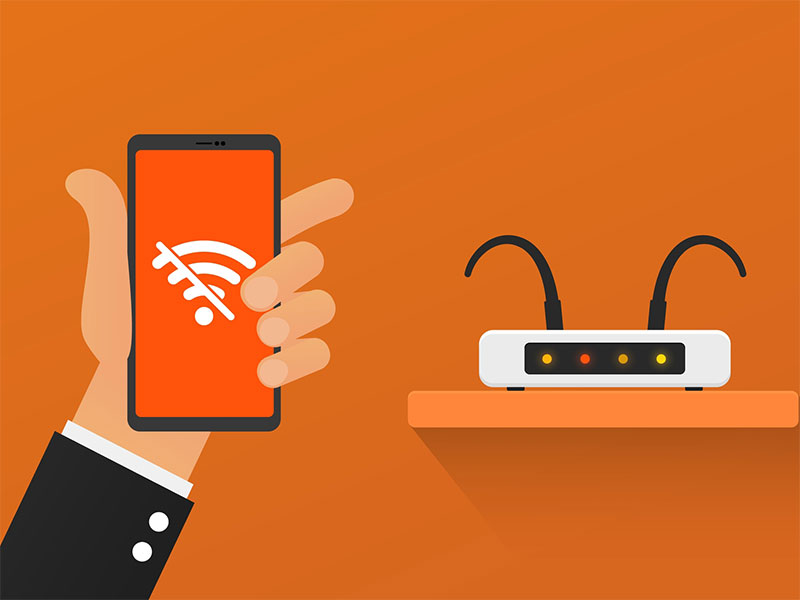 iPhone Won’t Connect to WiFi? Here’s How to Fix It
iPhone Won’t Connect to WiFi? Here’s How to Fix It  Why Your Phone is Slow & How to Speed It Up
Why Your Phone is Slow & How to Speed It Up  What Is a Burner Phone & When Should You Use One?
What Is a Burner Phone & When Should You Use One?  iPhone Water Damage Repair: 3 Options & What They Cost
iPhone Water Damage Repair: 3 Options & What They Cost 

